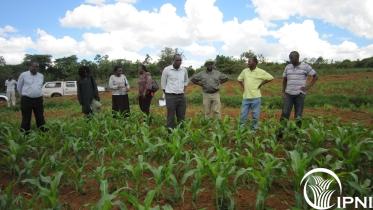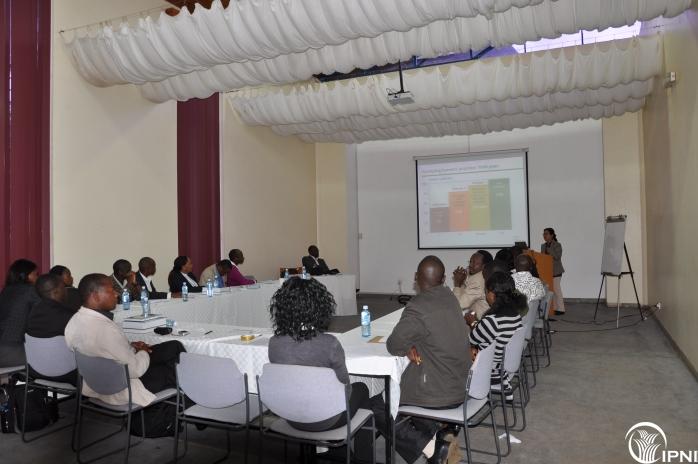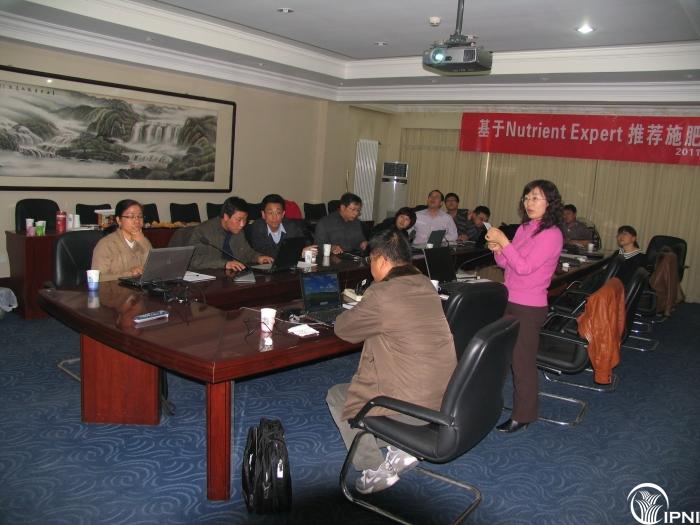03 Sep 2012
Nutrient Expert software for nutrient management in cereal crops
Adapted from: M.F. Pampolino et al. 2012. Computers and Electronics in Agriculture 88: 103-110
 Field visit and discussions with local maize stakeholders in Western Kenya
Field visit and discussions with local maize stakeholders in Western Kenya
- Nutrient Expert (NE) is a nutrient decision support software, which uses the principles of site-specific nutrient management (SSNM). NE enables crop advisors to develop fertilizer recommendations that are tailored to a specific field or growing environment. NE takes into account the most important factors affecting nutrient management recommendations and uses a systematic approach of capturing information, which is important for developing a location-specific recommendation. Yet, NE does not require a lot of data nor very detailed information as in the case of many sophisticated nutrient decision support tools, which could overwhelm the user. NE allows the users to draw the required information from their own experience, the farmers’ knowledge of the local region, and the farmers’ practices. NE can use experimental data, but it can also estimate the required SSNM parameters using existing site information.
As a computer-based decision support tool, NE combines all the steps and guidelines in SSNM into simple software tailored for crop advisors especially the not-so-technical users such as the extension agents in developing countries. In such countries, many crop advisors from both public and private companies do not have the data and facilities needed to run sophisticated models. The parameters needed in SSNM are usually measured in nutrient omission trials installed in farmers’ fields, which require at least one crop season. With NE, parameters can be estimated using proxy information, which allows crop advisors to develop fertilizer guidelines for a location without data from field trials.
NE fertilizer recommendations based on SSNM
NE provides fertilizer recommendations that are consistent with SSNM strategies for managing fertilizer N, P, and K. The algorithm for calculating fertilizer requirements in NE is determined from a set of on-farm trial data using SSNM guidelines. In SSNM, the N, P, and K requirements are based on the relationship between the balanced uptake of nutrients at harvest and grain yield, called internal nutrient efficiency, which are predicted using the quantitative evaluation of the fertility of tropical soils (QUEFTS) model. The fertilizer requirement for a field or location is estimated from the expected yield response to each fertilizer nutrient, which is the difference between the attainable yield and the nutrient-limited yield. These parameters are determined from nutrient omission trials in farmers’ fields, while attainable yield is the yield for typical year at a location using best management practices without nutrient limitation. Nutrient-limited yield is that when only the nutrient of interest is omitted. The amount of nutrients taken up by a crop is directly related to its yield so that the attainable yield indicates the total nutrient requirement and the nutrient-limited yield indicates the indigenous nutrient supply. The yield response indicates the nutrient deficit, which must be supplied by fertilizers. NE follows the SSNM guidelines for fertilizer application and split dressings, which consider the crop’s nutrient demand at critical growth stages.
Decision rules for use of proxy information to estimate SSNM parameters
NE estimates the attainable yield and yield response to fertilizer from site information using decision rules developed from on-farm trials. NE uses:
(a) Characteristics of the growing environment: water availability (irrigated, fully rainfed, rainfed with supplemental irrigation) and any occurrence of flooding or drought;
(b) Soil fertility indicators: soil texture, soil color and organic matter content, soil test for P or K (if any), historical use of organic materials (if any), problem soils (if any);
(c) Crop sequence in the farmer’s cropping pattern;
(d) Crop residue management and fertilizer inputs; and
(e) Farmers’ current yields.
Data for specific crops and geographies are required in developing the decision rules for NE. The datasets must represent diverse conditions in the growing environment characterized by variations in amount and distribution of rainfall, crop cultivars and growth durations, soils, and cropping systems.
NE development process
NE is developed through collaboration with target users and local stakeholders. Collaboration through a participatory approach ensures that NE meets the users’ needs and preferences, which could increase the likelihood of its adoption. Crop advisors from the public sector (e.g. Department of Agriculture) and private sector (e.g. fertilizer and seed companies) as well as scientists and extension specialists are key players in the development of NE.
Collaboration is carried out through a series of dialogues, consultations, and partnerships towards (a) collection of locally-available agronomic data and information, (b) integration of local user’s preferences such as use of local language, measurement units, locally-available fertilizer sources, etc., and (c) field testing, evaluation, and refinement of the NE software. Consultation meetings, meant to facilitate a sense of product ownership, include scientific discussions, demonstration of a prototype version of NE, assessment of needed data and information, and planning for field testing and evaluation.
Current NE versions
NE is developed for specific crops and geographies. Nutrient Expert for Hybrid Maize (NEHM) for favorable tropical environments (e.g. Southeast Asia) was developed in late 2009 and consequently undergone field evaluation in Indonesia and the Philippines. Using NEHM as a model, the NE concept has been easily adapted to other crops and geographic regions or countries. In 2011, beta versions of NE for maize were developed for India, China, Kenya, and Zimbabwe. Likewise, beta versions of NE for wheat were developed for South Asia as well as China.


